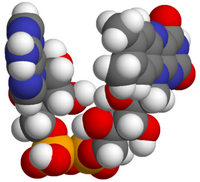
Photo from wikipedia
Abstract Conformational changes in the single mutated flavin mononucleotide binding proteins (FBP), E13K (Glu13 of wild type FBP is replaced by Lys), E13R (Glu13 replaced by Arg), E13T (Glu13 replaced… Click to show full abstract
Abstract Conformational changes in the single mutated flavin mononucleotide binding proteins (FBP), E13K (Glu13 of wild type FBP is replaced by Lys), E13R (Glu13 replaced by Arg), E13T (Glu13 replaced by Thr) and E13Q (Glu13 replaced by Gln) upon dimer formations were studied through the phenomena of photoinduced electron transfer (ET) from tryptophan 32 (Trp32) and tryptophan 106 (Trp106) to the excited isoalloxazine (Iso∗). The ET rates were obtained with atomic coordinates of the proteins determined by a method of molecular dynamics simulation (MDS) and an ET theory using the reported experimental fluorescence decays of the FBPs. The value of the net electrostatic energy (NetES) between the photo-products and ionic groups inside the proteins increased in magnitude upon the dimer formation in every mutated FBP. Dependencies in the logarithmic ET rate (ln Rate) on the donor-acceptor distances (Rc) could not be approximated with simple linear nor parabolic functions in most ET donors, which are ascribed to the relatively greater values of the NetES in the dimers compared to the energy terms of the standard free energy gap (SFEG), solvent reorganization energy (SROE) and the electrostatic energy between the photo-products (ESDA) in total free energy gap (GT) in the ET rates. The NetES vs Rc relations displayed two distinct groups in Trp32KB, Trp32QA and Trp32QB. The ln Rate vs Rc relations in these donors displayed different behaviors between the two groups.
Journal Title: Computational and Theoretical Chemistry
Year Published: 2017
Link to full text (if available)
Share on Social Media: Sign Up to like & get
recommendations!